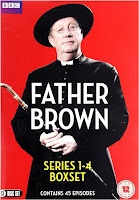 |
| (Amazon UK link) |
One of our sons had seen the show, and liked it so much that he sent us a DVD box set of the first four seasons for Christmas 2022. We started watching it towards the end of January 2023, and have watched one episode most weeks (occasionally two episodes) since then. We finally reached the end of the fourth season last night.
My first surprise was that the series is set in the 1950s rather than at the start of the century when Chesterton was writing. Mark Williams, whom we knew as Arthur Weasley in the ‘Harry Potter’ films, is excellent in the title role. However, he’s not at all as I had imagined Father Brown from Chesterton’s writing. Still, once I realised that the series is ‘inspired by’ Chesterton’s character rather than actually based on the stories, I was able to adjust and see the TV show for what it is. The TV Father Brown is certainly wise, energetic, kind and likeable. He’s also quite persistent, and has a lot of courage.
His Irish housekeeper, Mrs McCarthey (Sorcha Cusack, whom I recall as a much younger ‘Jane Eyre’ in the 1970s adaptation) is an excellent addition to the storyline. She provides some stability to Father Brown’s life, cooking meals for him, dealing with church accounts, and generally accompanying him in his ministry as well as his criminal investigations. She is also responsible for some low-key humour now and again; although these are crime stories, they have moments of light-heartedness which we appreciated.
Two other significant characters are the wealthy Lady Felicia (Nancy Carroll) and her driver Sid (Alex Price). Sid isn’t part of Father Brown’s congregation, and has some criminal tendencies himself, such as the ability to pick locks; this regularly comes in useful during investigations. Lady Felicia is a bit snooty but very generous, and she often clashes with Mrs McCarthey although the two are, deep down, quite fond of each other.
As always, what I appreciate most in a film or TV series is the characterisation, and I thought that excellent, particularly between the four principle actors. There’s also some banter - and some antagonism - between Father Brown and the local police inspector. In the first series this is Inspector Valentine (Hugo Speer), and in the second and third season he is replaced by Inspector Sullivan (Tom Chambers). Both gradually come to respect Father Brown, and reluctantly admit it in their final episodes when they are moved to other locations.
The third inspector is introduced at the start of the fourth season: Inspector Mallory (Jack Deam) is the most cynical of all, but gradually develops a kind of grudging liking for Father Brown, despite calling him ‘Padre’, and regularly telling him to leave the scene of the crime. Sergeant Goodfellow (John Burton) makes a good foil for the inspectors, and usually has a lot of respect and trust in Father Brown.
The stories themselves are widely varied. In forty-five episodes, we didn’t think any of the settings were the same. There’s an overall theme, of course: in most of them somebody dies or is found dead, and eventually Father Brown figures out who the perpetrator was. He uses his intuition, his excellent observational skills, and his knowledge of human nature to probe deeply into what has happened, and why. He saves many innocent men from execution - for this is the era when people were still hanged if believed guilty of a serious crime.
Most of the stories are set in the village of Kembleford where everyone knows everyone else, although some include visitors, and there are some residents whom we only meet once or twice. There are stories set in local homes, involving a variety of people from the Pope to visiting vagabonds. Some relate to former war crimes, some to family feuds, some to medical discoveries or abuse… and so much more. Each time we think the writers must surely have run out of ideas, yet another setting or motive emerges.
I very much liked the slow pace of the series, and the countryside images as well as the interactions between the main characters. I also appreciated the lack of gore; occasionally I had to close my eyes, but there was very little overt violence, and the bodies, when shown, mostly looked asleep. The overall rating of this box set is 12, which I think is about right, given the nature of the plots; it's unlikely to appeal to children anyway.
I appreciated the way that God is taken seriously, too. It’s not a ‘preachy’ series, but, like Chesterston’s original, Father Brown comes across as a devout man with a living, vibrant faith.
Still, having watched four series over the past twelve months, it’s time for a change. So although I would recommend this to anyone who likes light crime television, we’re not going to look for the later seasons on DVD.
No comments:
Post a Comment